You probably encounter oil-based paint when renovating older homes. It was popular decades ago because it’s tough, self-levels, and creates a flawless finish. For those reasons, painters favored it for high-impact areas like trim, cabinets, and doors. Today, however, many property owners don’t want to use oil-based paint for various reasons. So, as your customers lean more towards water-based and latex paints, you can discover how to successfully paint over oil-based paint with these tips and tricks.
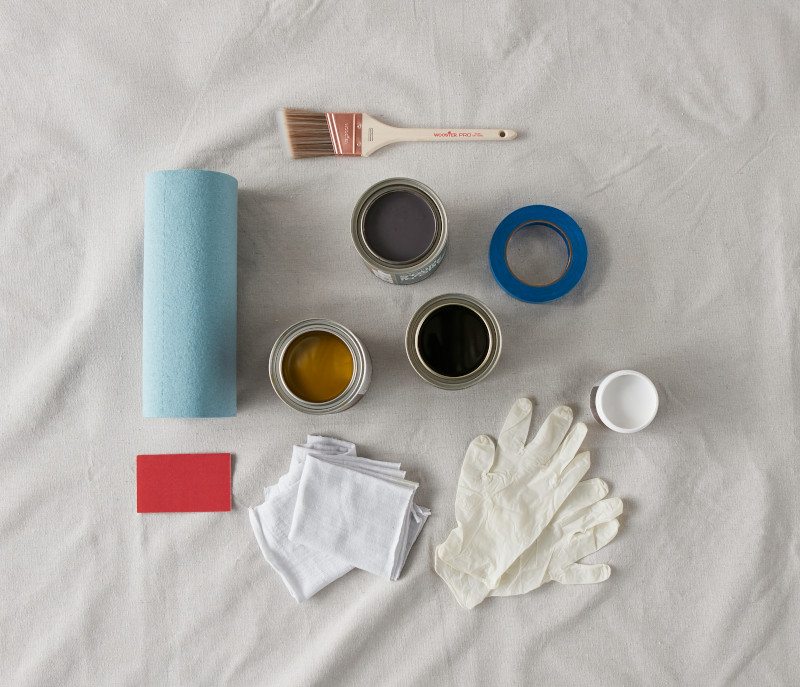
Benefits of Water-Based Paint
If you’ve ever shaken a salad dressing to get the oil and vinegar to blend, you can understand why water-based paint and oil-based paint don’t stick to each other. One is made with a water solvent, the other with oil. And with advances in technology, water-based paint can now perform as well as oil-based in most applications, and it has many benefits.
- It has a lower VOC content.
- Since it produces fewer fumes, you can use it in occupied spaces.
- Water-based paint saves natural resources and requires less energy to produce.
- It cleans well with soap and water.
- It adheres well to most substrates and produces a high film thickness.
In addition, water-based paint is preferred when covering an oil-based product because it has a faster drying time and resists fading in the sunlight for exterior applications.
How to Paint Over Oil-Based Paint with Water-Based Paint
Since adhesion is the main problem when covering oil-based paint, you must properly prepare the surface. But first, make sure you know what the existing paint covering is. Do this by rubbing the surface with a cloth moistened with denatured alcohol. If it picks up the color, the paint is water-based. If not, it’s oil-based. To prep an existing oil-based coating, follow these steps:
- Make sure the existing coat is fully cured. If the coating is over seven to 30 days old and can be scrubbed without affecting the finish, consider it cured.
- Use fine-grit sandpaper (180-220 grit) to remove the gloss from the surface. Scrape off any chipped or peeling paint and fill cracks or dents with wood putty.
- Once the filler is dry, sand it smooth with the fine-grit paper.
- Remove all the sanding dust by rubbing lightly with a tack cloth. Beeswax gives tack cloth its tackiness. If you press too hard, you could leave some of the wax behind.
- Use a sponge to thoroughly clean the surface with a solution of a ¼ cup trisodium phosphate (TSP) in a gallon of warm water. Always use TSP in a well-ventilated area and wear personal protective equipment. For optimal paint adhesion, cover the oil-based paint with a high-quality primer such as those listed below. If any color or stains show through, apply a second coat of primer.
Under optimal conditions, these BEHR® primers listed below are ready for topcoat after one hour. Once completely dry, apply one to two coats of the desired BEHR water-based topcoat. Allow two hours of dry time in between coats.
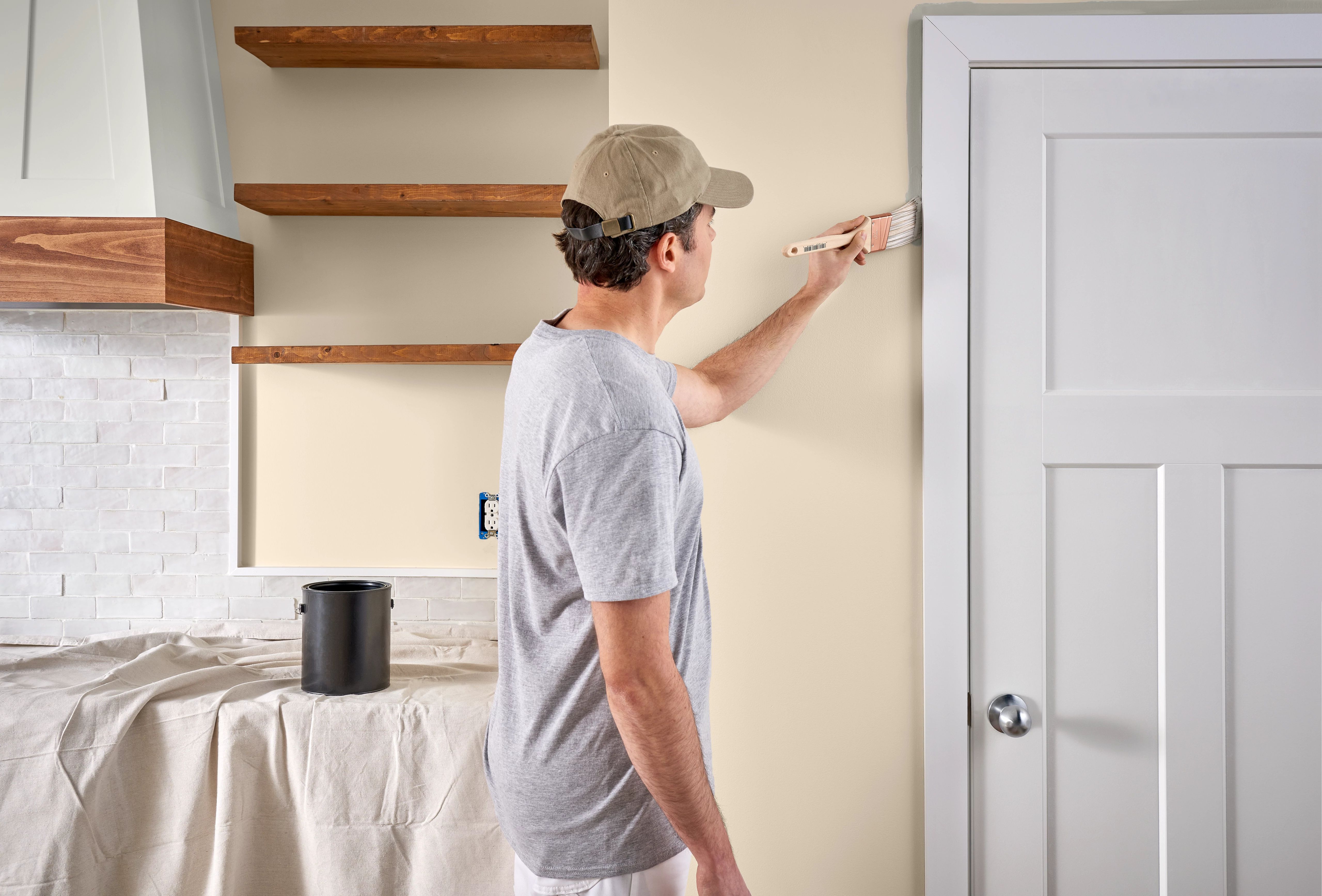
Tips for Painting Over Oil-Based Paint with Oil-Based Paint
You may have reasons to use oil-based paint. For superior coverage on trim and doors of high-traffic areas, surfaces subject to high levels of moisture, or exterior applications, some painting professionals choose an oil-based covering. So, if you’re painting over oil-based paint with more oil-based paint, here are a few tips to consider.
- Make sure the existing coat is fully cured. If the coating is over seven to 30 days old and can be scrubbed without affecting the finish, consider it cured.
- If the existing natural oil-based coating hasn’t cured, only use a natural oil-based paint to cover it.
- To cover an alkyd paint that hasn’t cured, use an alkyd or a natural oil-based paint.
Ideal Primers and Topcoats for Painting Over Oil-Based Paint
Behr Paint Company’s highly-rated, award-winning paints deliver superior value and transform any space into one of beauty. With Behr’s premium-quality paints and primers, you’ll find a wide range of colors that offer dependability and durability for interior and exterior applications. When painting over oil-based paint, consider the following BEHR® products:
BEHR® Multi-Surface Stain-Blocking Primer & Sealer
Use BEHR Multi-Surface Stain-Blocking Primer & Sealer on properly prepared, uncoated, and previously painted interior and exterior surfaces. Its styrene-acrylic formula resists medium to heavy stains and adheres to a wide variety of surfaces including wood and metal. In addition, BEHR Multi-Surface Stain-Blocking Primer & Sealer helps resist peeling and corrosion, making it a great option for different types of projects.
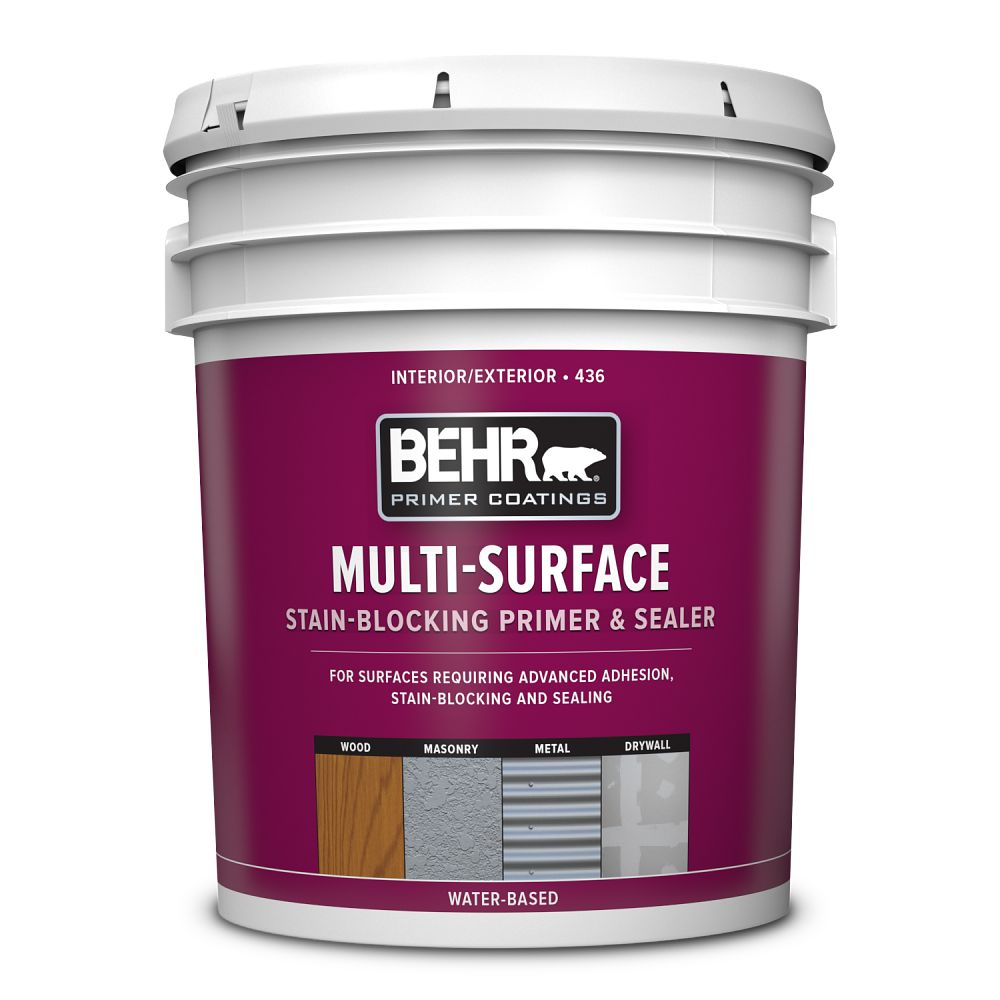
BEHR® Bonding Primer
BEHR Bonding Primer is specifically formulated to adhere to ‘tough-to-paint’ surfaces, providing a strong foundation for topcoats with little need to sand dense and glossy surfaces. Use under epoxies, lacquers, and products containing xylene or other hot solvents when allowed to dry for 24 hours before topcoating. Also, always test in an inconspicuous area before applying a full coat.
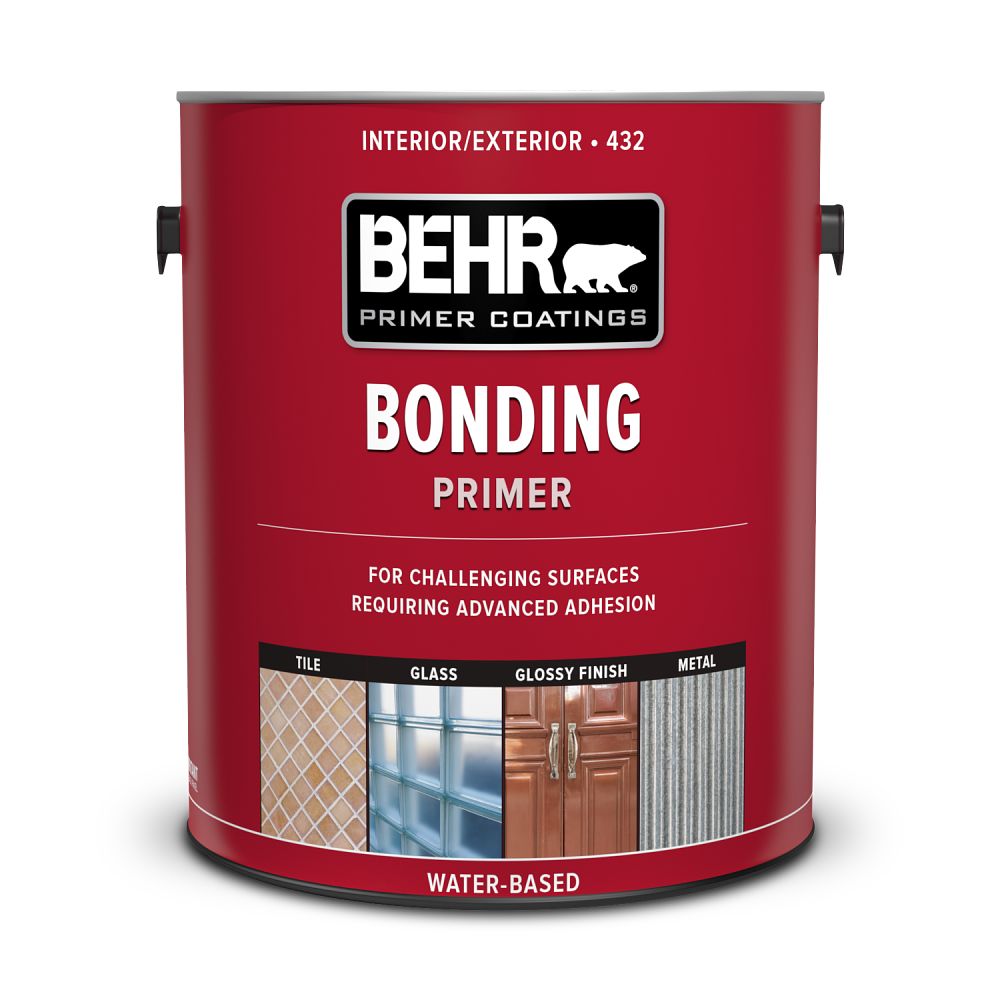
BEHR® Acrylic-Alkyd Enamel Undercoater
BEHR Acrylic-Alkyd Enamel Undercoater flows and levels similar to oil-based primers – which helps create a smooth topcoat appearance – but with easy soap and water clean-up. It also blocks tannin stains, making it an excellent choice for cabinet and door projects.
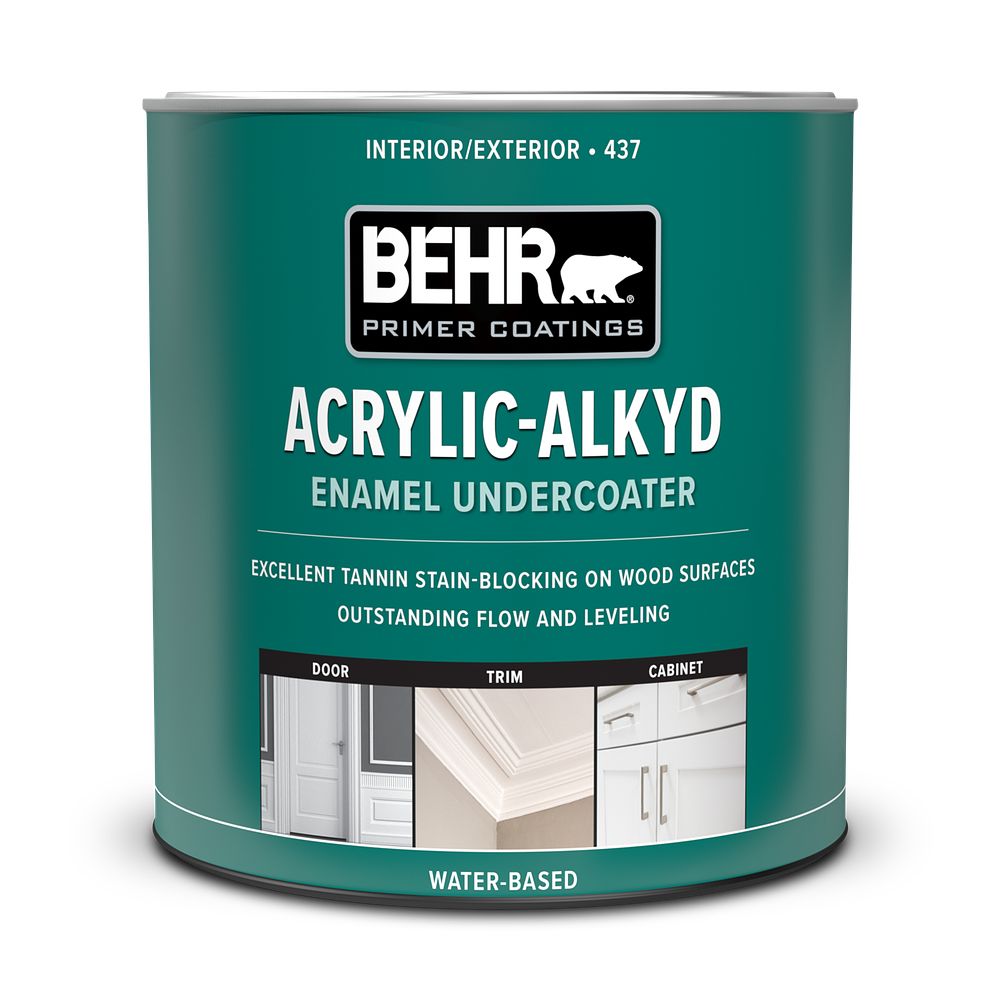
BEHR MARQUEE® Exterior Paint & Primer
BEHR MARQUEE Exterior Paint & Primer is our most advanced paint and primer. It delivers exceptional durability and provides a tough, non-stick surface that resists dirt. Its UV protection resists fading and retains gloss. In addition, BEHR MARQUEE Exterior Paint & Primer withstands early rain, blocks stains, and has an antimicrobial, mildew-resistant finish. This high-performing paint can be applied in low temperatures and guarantees a one-coat hide in over 700 colors*.
BEHR® primers and topcoats offer the dependability you need to paint with confidence. To learn more about painting over oil-based paint, contact your BEHR® Pro Rep.
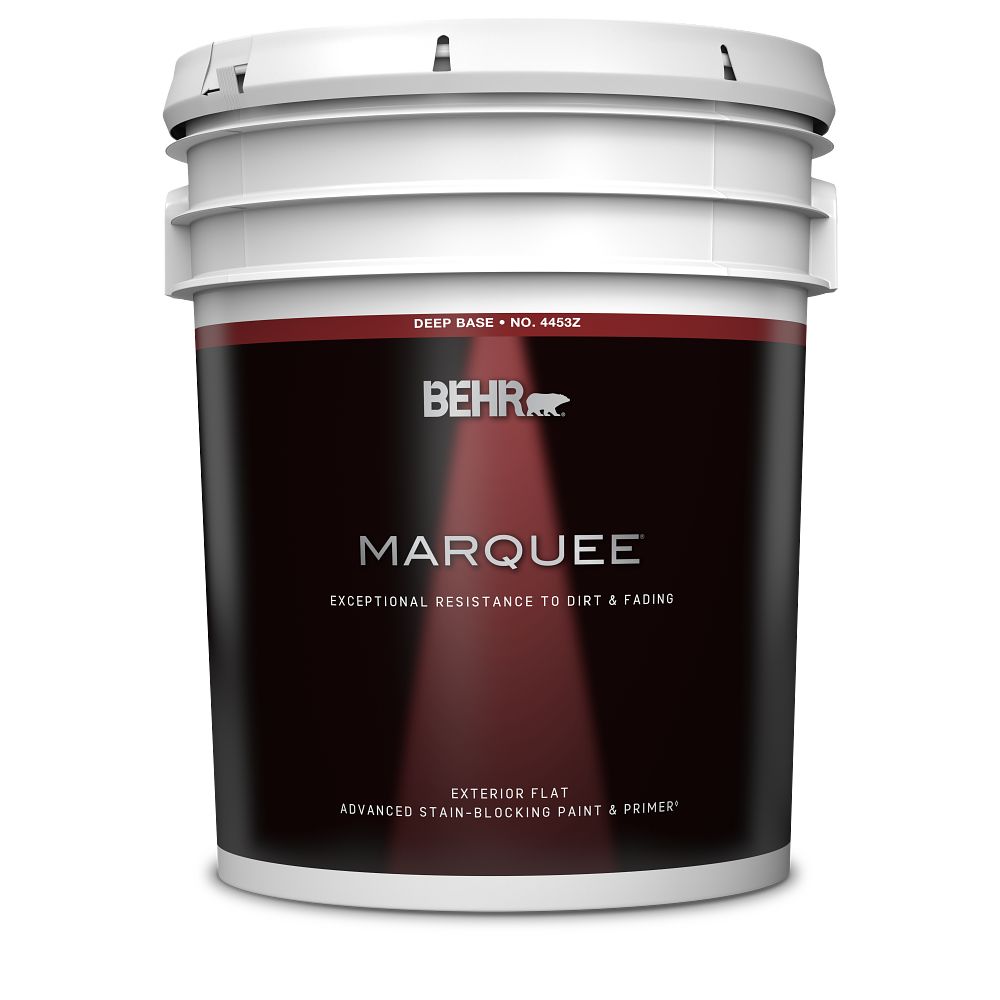

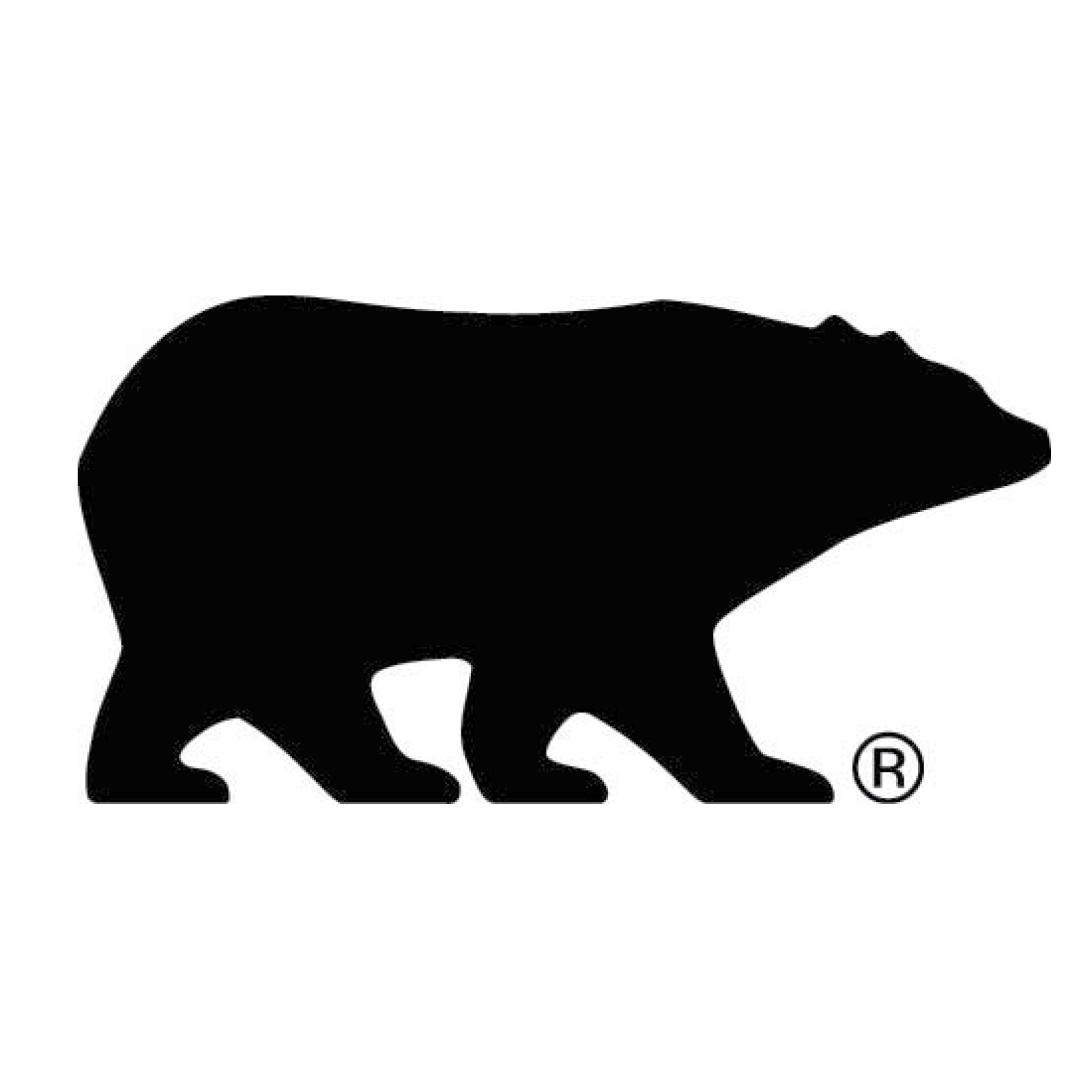
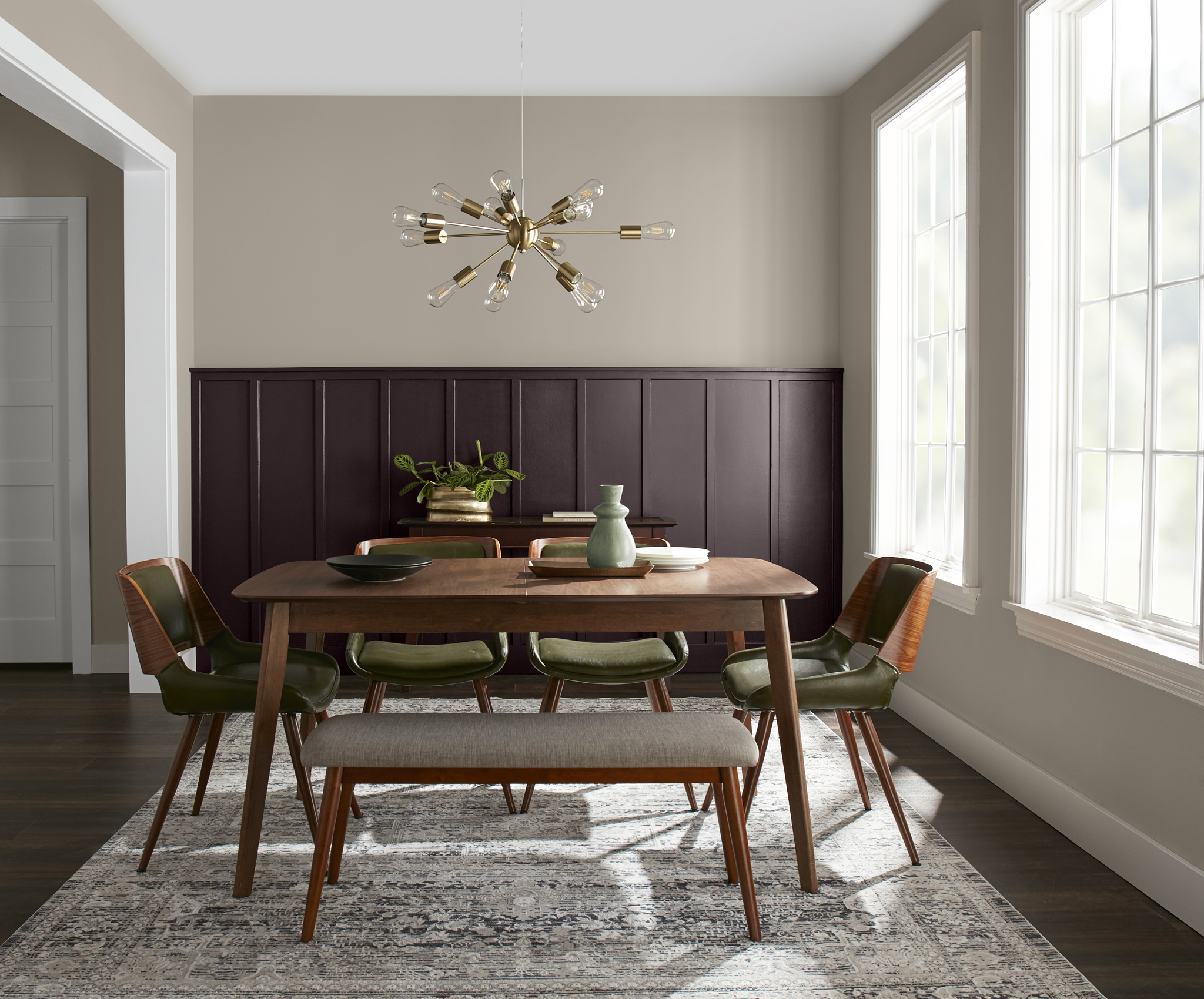

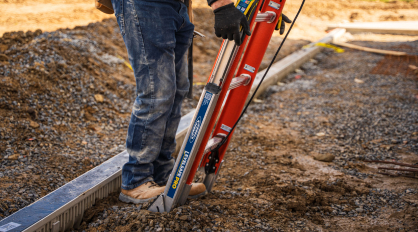
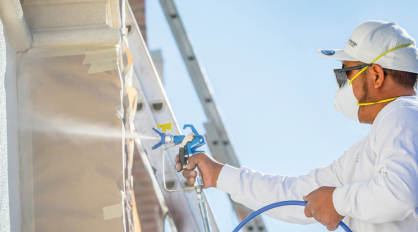

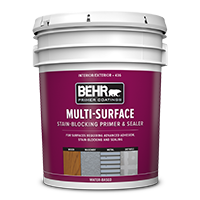
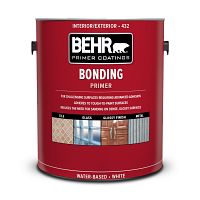

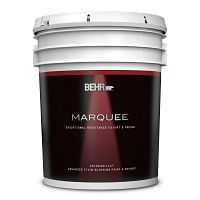
I used Thompson Ceder Thompson Timber Oil Stain on a new railing which didn’t cover what the color stated 2 days ago. So now I’m thinking of trying to paint porch rails with paint to hopefully match a Cherry Mahogany color. Does BEHR make a primer that I can use to cover the Timber Oil so that I can paint the porch rails which are 2×2 redwood and last.
Hi Michael,
First, you will want to go through the proper steps to completely remove the Thompson’s coating by stripping and cleaning the surface. The recommendation for Weather-Wood Surfaces is explained in our Technical Data Sheet here. Once complete, you could use any number of Behr’s exterior wood stains on the railing tinted to the color of your choice. For any of those products, a primer would not be needed once the surface is properly prepared.
Here is a link to BEHR Premium Solid Waterproofing Stain & Sealer in a white tint base.
BEHR DECKplus Solid Color Waterproofing Wood Stain would also be an option as would either of our Semi-Transparent Exterior Wood Stains if you would like to see some of the grain of the wood.
Kindly,
The BEHR PRO Team
I applied rust-oleum clean metal primer on a metal gate, which gave it a nice metal color; afterwards I applied a rust-oleum brown gloss enamel paint to give the gate a brownish color; however, the paint does not provide the appropriate coverage and the white primer color is visible in some areas (despite a section with 4 applied layers); it makes me wonder whether a bonding primer would have to be applied before applying the rust-oleum brown enamel paint would be applied. Any advise?
Hi Piet,
The problem is hide over a white primer. Bonding primer would be no different in this case. Rust-oleum states to apply one coat every 24 hours to avoid rewetting the coating. For future use, we suggest using a red oxide metal primer from Rust-oleum. Visit rustoleum.com for more information.
Kindly,
The BEHR PRO Team
I have bought a oil base red paint to paint my metal barn, I’m wondering what primer I should use the paint is almost gone on the tin what prep would I need to do to it before primeing
Hi Greg,
We suggest scraping the loose paint, removing the rust with a wire brush or sanding it, washing the existing shed, and letting it dry. Assuming the shed is made from aluminum, we recommend using our BEHR Metal Primer or our BEHR Multi-Surface Stain-Blocking Primer & Sealer. If it is rusting, then the shed would be steel, in which case we recommend using our BEHR Metal Primer or an Oil-Based Primer.
Please contact a BEHR Pro Rep with additional questions.
Kindly,
The BEHR PRO Team
I have kitchen cabinets that were painted well over two years ago by the person who lived here before. It’s been vacant for the past two years. The cabinets smell like oil based paint. I’ve left the doors open well over 6 weeks. They still have that smell. What can I do to get rid of the oder?
Hi William,
There are two options to remove the odor: (1) You can use activated charcoal, such as OdoBan Air Purifying Charcoal Odor Eliminator to absorb the smell; or (2) Repaint it with a water-based coatings system using the following steps.
(1) Clean the surface to remove any dirt or other foreign contaminants; (2) Sand with 220 grit sandpaper and make sure to remove sanding dust; (3) Apply BEHR® Bonding Primer; and (4) Apply the water-based topcoat, e.g., BEHR PREMIUM® Cabinet, Door & Trim Enamel.
The second option is more effective but time-consuming and costly.
Kindly,
The BEHR PRO Team
I am painting an interior that has painted trim. The trim has oil based paint from the 1980s. It needs to be repainted. What are the best products to use to ensure the water based bonds to the old oil based?
Hi Kinsey,
Please follow these steps: (1) Clean the surface to remove any dirt or other foreign contaminants; (2) Sand with 220 grit sandpaper and make sure to remove sanding dust; (3) Apply BEHR® Bonding Primer; and (4) Apply the water-based topcoat, e.g., BEHR PREMIUM® Cabinet, Door & Trim Enamel.
Kindly,
The BEHR PRO Team
I bought an older home in Colorado Springs a few years ago and the wood deck was painted with an oil based paint. I would like your recommendation on what paint to use for a durable repaint job, oil verses water based and what primer to use?
Regards,
Charles
Hi Charles,
After preparing the deck properly (i.e., cleaning, removing peeling/flaking paint, and sanding), we recommend using BEHR® Multi-Surface Stain-Blocking Primer & Sealer and then top coating with BEHR PREMIUM® Solid Color Weatherproofing All-In-One Wood Stain & Sealer. It is important to recognize that the paint you apply will only be as strong as the adhesion of the existing oil-based paint to the wood deck; hence any surface preparation short of total removal of the old coating may compromise the service length of the new paint job.
Kindly,
The BEHR PRO Team
I have a metal exterior door that was painted with an oil-based glossy paint about 10 years ago (and has been retouched occasionally). I want to repaint it a different color this year. What process and primer would be best for this?
Thanks!
Hi Sarah,
Here are some suitable paint colors for your exterior door: Very Navy M500-7, Maple Glaze PPU3-16, Dark Everglade HDC-CL-21A or Dandelion Wish MQ4-12. Each of these hues represent different tones with a nice pop of color.
As for the process, please follow these steps:
Surface Preparation: Remove any dirt, grime, or other surface contaminants. Lightly sand the surface to create a roughened surface profile for better adhesion.
Priming: Apply one coat of BEHR® Bonding Primer, or if there’s rust, BEHR® Metal Primer. Allow to dry completely before applying topcoat.
Painting: Depending on the desired appearance, use BEHR PREMIUM® Direct-To-Metal Semi-Gloss Paint or BEHR PREMIUM PLUS® Hi-Gloss Enamel Paint. Apply two coats, allowing ample time between coats. Refer to the product label for specific details on recoat time.
Kindly,
The BEHR PRO Team
I want to paint my front door with a water based paint. It has an oil based gloss on it. Is it possible to put water based paint over an oil based
Hi Mary,
Yes, you can apply water-based paint over oil-based paint, but proper surface preparation is essential for good adhesion and a durable finish. This involves cleaning, sanding, and priming before applying the water-based paint. For interior projects, these steps are generally straightforward and effective. However, for exterior surfaces, the process is more complex. If the surface has multiple layers of oil-based paint, it is advisable to continue using oil-based paint. The flexibility and expansion/contraction rates of water-based paints can cause issues when applied over multiple layers of oil-based paint, which is less flexible. For additional questions, please contact your local BEHR® Pro Rep.
Kindly,
The BEHR PRO Team
Help! Through a comedy of errors, we have accidentally used an oil-based semi-gloss paint in our living room instead of the flat latex paint we should have used. We don’t like the sheen and it shows lots of spots that have never shown before when using latex paint. Is there anything we can do, other than wait a month and go through all the sanding/priming and repainting? If we do a second coat with a satin finish, will it look any better?
Hi AS,
Adding another coat with a satin finish will offer marginal improvements. Flat paint is favored for surfaces with numerous imperfections because its non-reflective nature helps conceal flaws. Regrettably, there’s no quick fix to address your issues.
Kindly,
The BEHR PRO Team
I have a front door with oil based paint on it. Can i use BEHR PREMIUM Oil-Base Satin Enamel directly over the oil based paint?? TYVM
Hi Phil,
Yes, you can use the product, but be sure to scuff sand and wipe the door first. It is also recommended to prime before applying the product for optimal results.
Kindly,
The BEHR PRO Team
oh dear, I just painted the doors in my home. Did not realize they must have been oil base paint on doors. Painted with latex paint. did not use primer. Now what do I do? I am easy on the doors, so coming in and out with items will not scratch them, BUT when someone told me do a scratch test, I ran my finger nail with a little pressure and the new paint came off. How can I fix this issue? I figured I would likely have to somehow get the latex paint off and then prime and repaint, but how do I get the latex paint off?
Hi Cathy,
Unfortunately, there is no easy solution short of removing the most recently applied coating and starting over. To remove the poorly adhered coating, you can scrape it off with a putty knife, sand it, or use other mechanical methods. Afterward, smooth the surface by sanding with fine-grit (120-180) sandpaper, and be sure to wipe away the sanding dust. Once complete, we recommend priming it with either BEHR® Multi-Surface Stain-Blocking Primer & Sealer or BEHR® Bonding Primer. After allowing the primer to dry, preferably overnight, apply the desired topcoat.
Kindly,
The BEHR PRO Team
Hi there! I’m painting the exterior of a commercial building. It’s metal, factory finish, and I am wondering what type of primer to use. I was considering the “Direct to Metal” line. If we use this as a primer, will I need to add a bonding primer (like Bulls Eye 123 bonding primer) to the Direct to Metal paint to use acrylic or water based paint on top of it? Or will the acrylic paint adhere to the DTM without a problem?
Hi Nichole,
The best approach for painting factory-finished metal surfaces is to start with a primer like BEHR Bonding Primer, followed by a topcoat of BEHR Premium Direct-To-Metal Paint (Semi-Gloss No. 3200 or Eggshell No. 7200). The Bonding Primer is specifically designed to adhere to challenging surfaces, including Kynar, a fluoropolymer-based coating commonly found on factory-finished metal used in commercial structures.
Proper surface preparation is crucial before applying any coating. At a minimum, surfaces should be thoroughly cleaned to remove dirt, dust, and other contaminants. Additionally, areas showing signs of corrosion should be spot-primed with a rust-inhibitive primer like BEHR Metal Primer.
Even when using a bonding primer, light sanding can further improve adhesion—provided the surface allows for it, such as flat areas rather than contoured or tight spaces. Taking these steps will help ensure a durable, long-lasting finish.
Kindly,
The BEHR PRO Team